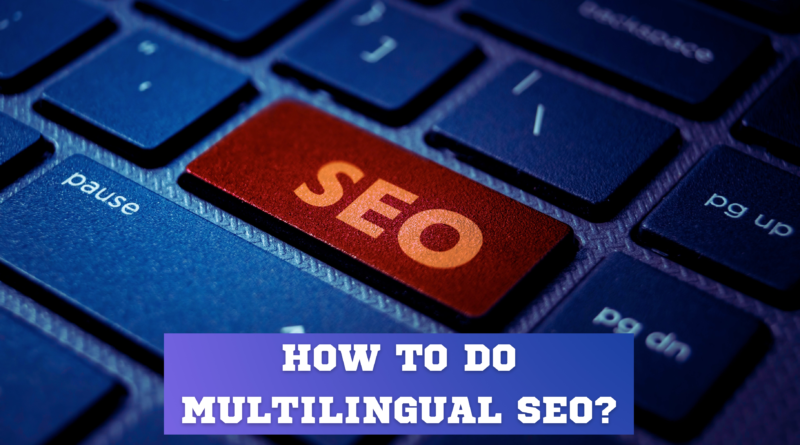Tips to Do SEO for a Multilingual Website [Comprehensive Guide]
What is a Multilingual Website?
A multilingual website is a site that has content in more than one language. Even though English is used in many countries, other languages, such as Chinese, Arabic, Spanish, etc., are also popular. Adding more languages to the website will take the business to a broader range of audiences.
Various studies have proved that multilingual websites have a better reach on search engines. According to Harvard Business Review, around 73% of online shoppers prefer websites with content in their language.
A CSA Research survey revealed that more than 72% of consumers spent more time on the website in their language.
Many people use international and multilingual interchangeably. Yet, they aren’t the same. A multilingual website can be limited to one country or region.
Here are Some of the Important Tips for Do Multilingual SEO
Effective Content Writing for Accurate Translation
Content is a primary factor for multilingual websites. You must write the content in one primary language and then translate it into other languages.
SEO tactics for a multilingual site are similar to the ones for a single-language site. The focus should be on writing quality content and providing valuable information to the users.
● Use clear headings and subheadings
● The language has to be simple and easy to understand
● Choose the translation method (human or Google translator)
● Double-check the tone, intent, and overall meaning
● Ensure the content is not offensive to users from other regions/ languages
● Place the CTA (call to action) buttons in the right places
See how affirm using CTA on its website.
Promote Translated Pages
Having translated or multilingual web pages is not enough. You’ve got to promote them to get more visibility and a higher ranking.
Many websites rank high for English or the primary language but not for other languages because the pages aren’t appropriately promoted. You’ll be required to spend the same effort on link building and referrals to web pages in other languages.
Link building through directories, influencers, backlinks, citations, etc., will improve the website’s authority.
When you do this for every language on the site, you’ll establish your brand value among different target audiences. It will directly impact your search engine visibility. Google will award your website with a higher rank and promote it.
Translate the URLs
When translating a webpage, you also need to focus on the URL. Users who look at the URL shouldn’t wonder where it leads them.
For example, your eCommerce website URL looks like ‘bakergirl.com/shop/cakes’ in English. It must be translated into other languages and reflected in the URL.
See how yelp has translated its landing pages into different languages.
The URL will change to ‘bakergirl.com/negozio/torte’ in Italian. Since ‘bakergirl’ is your brand’s name, it will remain the same irrespective of the language.
The simplest way to change the URL language is by modifying the ‘slug.’ It is nothing but the identifier after the domain name. The option can be found in the drop-down menu if you use TranslatePress, a WordPress plug-in.
Use hreflang Tags and Translate Metadata
hreflang tags are used to add more languages to the site. The tags make it easy for Google to differentiate between different languages on your site. There’s no need to edit the entire page code to add the tag.
TranslatePress plug-in makes it super easy to add the hreflang tags to your web pages. It automatically adds them whenever you add a new language to the site. Hreflang=en will imply that the webpage is in English.
Metadata includes the alt text, meta title, meta description, etc., of the webpage. If the metadata is not translated along with the content, it’ll be tough for that language-based page to rank on the search engine.
Popular Keywords from Other Languages
When you search for keywords, your focus will be on the primary language. But this will happen to the keywords when you translate the pages. After all, these are important for SEO and cannot be ignored.
For web pages in other languages to rank higher, you’ll need to search for popular keywords in the respective languages and bring them into use in the content. Even if you are using TranslatePress, you should manually ensure that the keywords are correctly used and relevant to the context.
The same keyword rules apply to all languages-
● No keyword stuffing
● Use short tail, long tail, and semantic versions
● Use keywords in the meta title, meta description, alt text, etc.
Local Link Building to Increase Traffic
As we mentioned in the previous points, link building is an effective way to increase website visibility. For a multilingual website, you must use local directories, bloggers, and influencers for backlinks to the respective web pages.
For example, you sell cosmetics in five countries. You’ll need to reach out to bloggers in each country and get a backlink for the respective webpage.
Take a look at this cosmetic website gaining links from the Yellowpages website.
The influencer from Spain will share a link to the Spanish website, and so on. It will bring your website more traffic from all parts of the world.
Users who don’t use English/your primary language will continue to browse the website in their native tongue.
Understand Your Target Audience
Though we’ve listed this tip halfway through, it’s vital to consider when creating content in multiple languages. Every language has commonly used words and phrases. These help users connect to the topic/ product/ service.
English has many versions like American, British, Australian, and Canadian. But users more or less understand the context without trouble.
We can’t say the same for other languages. The familiar words tend to change depending on the region and create trouble translating web pages.
The biggest example is the difference in Spanish used in Spain and Central American countries (Mexico). You’ll need to use words depending on where your target audiences live.
Focus on Local (Country-Based) Search Engines
Using local language and link-building options is important, but you should also get the website to rank on local search engines. Countries like Russia have their search engines. According to various reports, almost 50% of Russians prefer to use Yandex.
By optimizing your website for local search engines, you can reach more users and increase website traffic. It also becomes easy to rank high on such platforms since the competition is comparatively less.
When the website traffic increases through local search engines, it will positively impact your position on Google. After all, website traffic is one of the ranking factors on Google.
Setup Multilingual Sitemap
Even if your website has visitors, it won’t help if they don’t stay long enough to engage with the content or buy a product. User engagement is determined by how easy or hard your website is to navigate and find products/ services.
A sitemap helps simplify the interface.
You can use online sitemap generators to generate sitemaps.
It also makes it easy for website crawlers to index web pages on search engines. The sitemap for a multilingual website should include all the web pages in different languages.
It also increases the number of web pages and gives users more opportunities to browse the site. The more time the users spend on your website, the higher your chances of improving the SEO rank.
Invest in Agency That Has Human Translators
Machine translators are no doubt more straightforward, cost-effective, and convenient. However, they cannot replace human translators.
Carly Bryanna of Haitna says, “Machines make mistakes and are not accurate enough for you to rely entirely on them. If you hire an SEO agency to optimize a multilingual website, find one with experienced human translators. “
It doesn’t mean that experts will manually translate every word and webpage into other languages. It means that the content will be double-checked by a human who speaks both languages after the machine translates it.
It saves time and energy. It also ensures that human translators rectify any mistakes made by the machine. You can also hire a freelance translator.
Use One Language per Page
It seems easier to translate only a part of the page to the targeted language and retain the rest in English. While it sometimes works, using multiple languages on the same webpage can affect user experience. It also makes it hard to index the webpage on Google.
Under which language will you promote it if the webpage has two or three languages?
If your website has forums or a community center, users from all regions may comment on it. It leads to many languages on the same page.
Since you can’t do anything about this, you can automatically translate the language and use Translate Page or related plug-ins.
Best Tools to Manage Multilingual Content
Notepad
Notepad looks too simple and ordinary to be of much use, isn’t it? But it is instrumental when you don’t want to lose the markup when editing the files. From making notes to copying translations, Notepad is efficient and effective.
It also doesn’t even take up any space on the hard drive or the CPU. You can use Notepad++ if you want to work on advanced editing. Not just that, you can also encode more languages into the code through Notepad++.
Email can also be used to translate content from one language to another. MS Outlook works excellently in such instances and is more accessible than other email platforms.
That said, translating large files to other languages is not possible through email. You’ll need to use FTP (File Transfer Protocol) or ZIP files.
If the email server blocks a ZIP file, rename the extension. Mention it in the email and ask the receiver to rename it again after downloading the file.
MS Office
Microsoft Office has been in use for a long time. Creating content in many languages in MS Word is relatively easy. You can either write in English and upload the file to a translator or download fonts from other languages and directly use them in MS Word.
Editing a Word document is easy and can be done n number of times. After the last edit, you can save the file as Read-Only to prevent edits by mistake.
FTP
FTP is an abbreviation for File Transfer Protocol and is a perfect choice for transferring large files. FTP is secure and safe to use. It makes it easy to send files for translations and get them back without corrupting or losing them.
That said, you’ll have to download the translated file and delete the actual one from the server. Otherwise, your hard drive will be packed to capacity in no time. Nowadays, many cloud-based platforms offer the same services as FTP.
Unicode Fonts
A Unicode font has characters from the Universal Coded Character Set (UCS). It is flexible enough when creating web pages in multiple languages. Each font has a unique code associated with it.
The code will be used across the platforms, making it easy to translate the web pages with the least number of errors. All Unicode fonts start with U, followed by a different series of numbers. You can use the corresponding HTML code for the alphabet to cross-check when coding the web pages.
Social Media
Doesn’t it sound strange that social media can be a multilingual management tool for businesses? Look at how Facebook, Twitter, and Instagram use their translation feature to help people connect.
Facebook allows us to see the translations for comments as well. The posts automatically translate to our default language when displayed on the newsfeed. It will let you interact with global audiences in their native language and promote the website.
PDF Creator
PDF is a Portable Document Format and is known to retain the formatting of the content. It is highly secure and a preferred choice for most professional users.
Similar to Unicode fonts that are cross-platform compatible, PDF files can be opened and used on different devices and OS.
Saving the multilingual content in PDF will ensure that the file can be read by anyone who knows the language. It is irrespective of whether their computer recognizes the font or not.
WordPress
WordPress is the most used CMS platform with a global community center. Many bloggers start with blogs on WordPress and build them into websites by purchasing the domains. The countless plug-ins available make it easy to use WordPress despite the language preferences.
Translating content on WordPress is by far the easiest if you use plug-ins. That’s because WordPress also uses Unicode fonts. However, the free translation plug-ins are not 100% accurate.
Multilingual SEO FAQs
1. Can multiple languages affect the SEO strategies for a website?
Yes, different languages can affect SEO strategies. You must optimize the web pages from foreign languages to make them visible on the search engine.
Adding the pages to the sitemap, indexing, using keywords from each language, and more. Localized content, geo-targeting, local link building, etc., are a part of the process. You should increase your SEO efforts to rank the web pages higher.
2. Is there any tried and tested strategy to optimize a multilingual website?
The tried and tested strategies are different for different businesses. While some prefer to use two localized websites, others like a single website with translated web pages.
Having country-specific domains usually works for multinational organizations and large enterprises. If you want to use the same site, you’ll need to optimize it for local search engines instead of relying only on Google.
3. How can I structure a multilingual website to increase SEO rank?
Using directories will help properly structure the website so that Google can index the pages and display them on the SERPs.
Using the hreflang tag should solve the problem. Using different domains or sub-domains, you’ll end up with two or more websites (according to Google).
It means you have to work on SEO independently for all the sites. That’s time-consuming and cost-intensive.
4. Is it better to have a multilingual website for effective SEO results?
In short, yes, it is better to have a multilingual website to gain more visibility on search engines.
However, it is necessary only if your target audiences belong to different regions and speak varied languages. Translated sites bring more traffic and reduce the bounce rate as users can read the content through translation.
5. How can I build a multilingual website? Is it easy or hard?
Building a multilingual website is not hard if you know what you want. Consider the following aspects when developing a website for different languages-
✓ Use human translators
✓ Decide on the number of domains
✓ Get the URL structure right (the sub-domains are mentioned before the brand name in the URL)
✓ Auto-switching is risky (give users the option to translate)
6. Can I use Google Translate for my multilingual website?
Google Translate is decent but not good enough for international websites.
You don’t want users to leave the site due to incorrect translations and grammatical mistakes. Idioms, phrases, and sarcasm can be lost in translation and cause more harm to your business.
While machine translations are fast, they are inaccurate and must be checked by a human translator.
7. Are there any reliable WordPress plug-ins for language translators?
It’s hard to declare a single plug-in as a reliable translator for WordPress. Avoiding free plug-ins is an excellent way to avoid mistakes on the website. That said, you can try the following language translator plug-ins:
✓ Polylang- free and works with most themes
✓ qTranslate X- free and similar to Polylang
✓ WPML- paid plug-in that’s considered one of the best
8. Is SEO the same for all languages?
Yes, SEO is the same for all languages. The process and the tactics are similar as the ultimate goal is to rank the webpage on the search engines.
Finding keywords, creating quality content, writing the sitemap and robot.txt files, etc., are used to optimize any website. A multilingual website has translators (either human or machine) to display the content in different languages.




